Enerhodar
Енергодар Энергодар | |
|---|---|
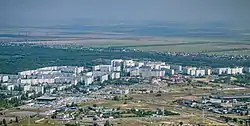 Enerhodar viewed from a thermal power plant chimney | |
 Flag  Coat of arms | |
| Motto(s): | |
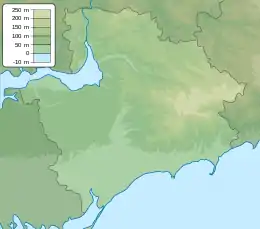 Enerhodar Location of Enerhodar in Zaporizhia Oblast  Enerhodar Location of Enerhodar in Ukraine | |
| Coordinates: 47°29′56″N 34°39′21″E / 47.49889°N 34.65583°E | |
| Country | |
| Oblast | Zaporizhzhia Oblast |
| Raion | Vasylivka Raion |
| Hromada | Enerhodar urban hromada |
| Founded | 1970 |
| City status | 1985 |
| Government | |
| • de jure Mayor | Dmytro Orlov[1] |
| • Russian appointed de facto mayor | Andriy Shevchik[2] |
| Area | |
| • Total | 63.5 km2 (24.5 sq mi) |
| Elevation | 29 m (95 ft) |
| Population (2022) | |
| • Total | 52,237 |
| • Density | 858/km2 (2,220/sq mi) |
| Area code | +380 6139 |
| Climate | Dfa |
| Website | www |
Enerhodar (/ɛnərˈhoʊdɑːr/; Ukrainian: Енергода́р, IPA: [enerɦoˈdɑr], lit. 'energy's gift'; Russian: Энергодар, romanized: Energodar) is a city and municipality in the northwest of Zaporizhzhia Oblast, Ukraine. It is on the south bank of the Dnieper River, on the opposite side of the Kakhovka Reservoir from Nikopol and Chervonohryhorivka.
Its main industry is electricity generation, at a coal-fired power station and a large nuclear power station. It has an estimated population of 52,237 (2022 estimate).[3] About 11,000 residents work at the nuclear power station.[4]
Since early 2022, it has been under Russian occupation.[5]
History
Enerhodar was founded on 12 June 1970 for building and serving the Zaporizhzhia thermal power station.
For two years, the town had no name. Zaporizhzhia TPP was under construction, and the town grew. On November 23, 1972, the village of power engineers was named Enerhodar.
The complex development of Enerhodar was combined with the high rate of construction of the thermal power plant. Residential areas, kindergartens, the Energodar Hotel, and the Palace of Culture "Sovremennik" were built simultaneously with the plant's units. Zaporizhzhia Thermal Power Plant reached full capacity in September 1977.
It obtained city status in 1985, while part of the Ukrainian Soviet Socialist Republic of the Soviet Union. Zaporizhzhia Nuclear Power Plant, the largest nuclear power plant in Europe, was built there in the 1980s. Construction of the building began in 1980, and its first unit was commissioned in late 1985. In 1991, the city became part of independent Ukraine.
The city's two power plants continue to be major employers for its inhabitants into the 21st century.
Russo-Ukrainian War
On 28 February 2022, Russia claimed to have captured the city and the nuclear power plant. The mayor of Enerhodar, Dmytro Orlov, denied the claim.[6]
Civilians built a large barricade of sandbags and vehicles on the road to the nuclear power plant in an attempt to hinder Russian troop advancement.[7] The Ukrainian military administration for the southeast confirmed on 7 March that Enerhodar had been occupied by Russian forces.[8]
Demographics
Points of interest
Gallery
 Victory Park
Victory Park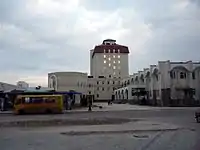 City Hall
City Hall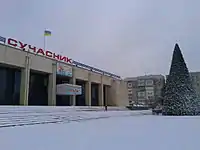 Suchasnyk Palace of Culture
Suchasnyk Palace of Culture WWII memorial
WWII memorial Enerhodar Hotel
Enerhodar Hotel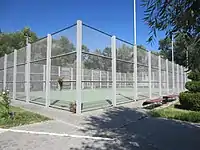 A tennis court
A tennis court
References
- ↑ "Enerhodar City Council". Енергодарська міська рада. 1 March 2022. Archived from the original on 1 March 2022. Retrieved 1 March 2022.
- ↑ "Оккупанты показали своего ставленника в захваченном Энергодаре: коллаборант – из ОПЗЖ" [The invaders showed their protege in the captured Energodar: collaborator from the Opposition Platform for Life]. news.liga.net. 27 March 2022. Retrieved 27 March 2022.
- ↑ Чисельність наявного населення України на 1 січня 2022 [Number of Present Population of Ukraine, as of January 1, 2022] (PDF) (in Ukrainian and English). Kyiv: State Statistics Service of Ukraine. Archived (PDF) from the original on 4 July 2022.
- ↑ Santora, Marc; Kramer, Andrew E. (23 August 2022). "In Ukraine, a nuclear plant held hostage". New York Times. Retrieved 28 August 2022.
- ↑ "Ukraine after 11th night of war: Mayor killed, towns taken, Moscow promises civilian corridors to Russia". Baltic News Network - News from Latvia, Lithuania, Estonia. 7 March 2022. Retrieved 8 May 2022.
- ↑ "Енергодар і Запорізька АЕС під контролем ЗСУ: мер міста просить не вірити фейкам" [Energodar and Zaporizhzhya NPP are under the control of the Armed Forces: the mayor of the city asks not to believe fakes]. ФАКТИ ICTV (in Ukrainian). 28 February 2022. Archived from the original on 28 February 2022. Retrieved 1 March 2022.
- ↑ Tiefenthäler, Ainara (2 March 2022). "Videos show large barricade, set up by civilians, blocking entrance to nuclear power plant". The New York Times.
- ↑ "Ukraine after 11th night of war: Mayor killed, towns taken, Moscow promises civilian corridors to Russia". Baltic News Network. 7 March 2022. Retrieved 7 March 2022.
- ↑ https://datatowel.in.ua/pop-composition/ethnic-cities
- ↑ https://socialdata.org.ua/projects/mova-2001/
External links
- Official municipality site Archived 1 October 2020 at the Wayback Machine
- Enerhodar portal
- Enerhodar, Ukraine — statistics